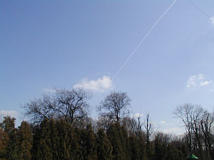Persistent Contrails - Clouds Protocol
Contrails - Persistent
|
Classic Persistent Contrail This is a classic example of a persistent contrail. The plane generating it is no longer in the area, yet this very thin and linear cloud remains across the sky. This contrail is quite thin - definitely less than the width of an index finger - yet it is very clear and continuous. Note there are also some isolated cumulus clouds in this photo. Photo by Doug Stoddard in Kiev, Ukraine. |
|
|
Compact Persistent Contrail This is another nice example of a persistent contrail. This contrail is quite compact and well-defined, yet it has clearly been in the sky for some time since the passage of the plane. Note there is some indication near the edges of the swirling air motions induced by the passage of the jet, but this contrail is holding together very well. While it is somewhat wider than the previous example, it has not exceeded the index finger test. Photo by Carol Clark in Oregon. |
|
|
"Loopy" Persistent Contrail This contrail is also very linear and quite compact, but the structure is much more clearly visible. The "loops" along the edges of the contrail are produced by the swirling motion of the air in the wake of the plane. This is often characteristic of contrails, and can be a helpful clue in distinguishing between contrail-generated and natural cirrus clouds. Photo by Carol Clark in Oregon.. |
|
|
Crossing Persistent Contrails This photo shows two somewhat different persistent contrails. Note that both are quite narrow. The contrail crossing the photo horizontally is well-defined and probably younger then the other contrail, which is beginning to fade. Both of these have a clear linear pattern, and some evidence of swirling air from the plane. The whitish sky, particularly in the upper left corner of the photo, is evidence of aerosols (small particles) suspended in the atmosphere. In this case, the likely cause is smoke particles, as tree debris from Hurricane Isabel were being burned during the time this photo was taken. Crossing contrails are quite common. They result from the fact that there are well-defined "highways" through the sky where most planes fly. These planes were probably passing over a particular navigational beacon where their paths crossed. Photo by Lin Chambers in Virginia. |
|
|
Intermittent Persistent Contrail Another common sight is the intermittent contrail. This results when a plane passes through parts of the atmosphere containing more or less water vapor. In the driest parts, no contrail forms at all; while in moderately dry parts the contrail may be noticeably thinner. To understand this phenomenon, refer to the Contrail Formation Guide (PDF). You can see a current global water vapor image to get an idea of how much water vapor varies (dark means dry; bright means wet). Note that there are some other very wispy clouds - likely cirrus - present in this photo. Photo by Lin Chambers in Virginia, summer 2005. |
|
|
Persistent Contrail at Twilight This photograph of a pink-tinged persistent contrail (center of image) at twilight was taken in Egypt. Photo by Aymen Ibrahem, October 2007. |











